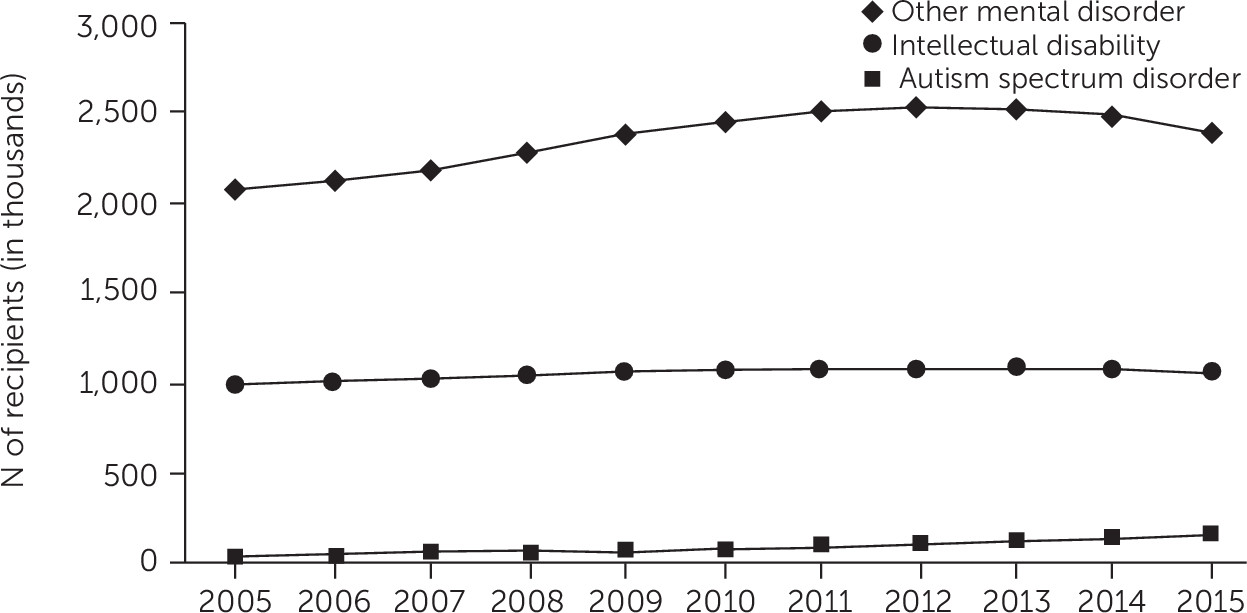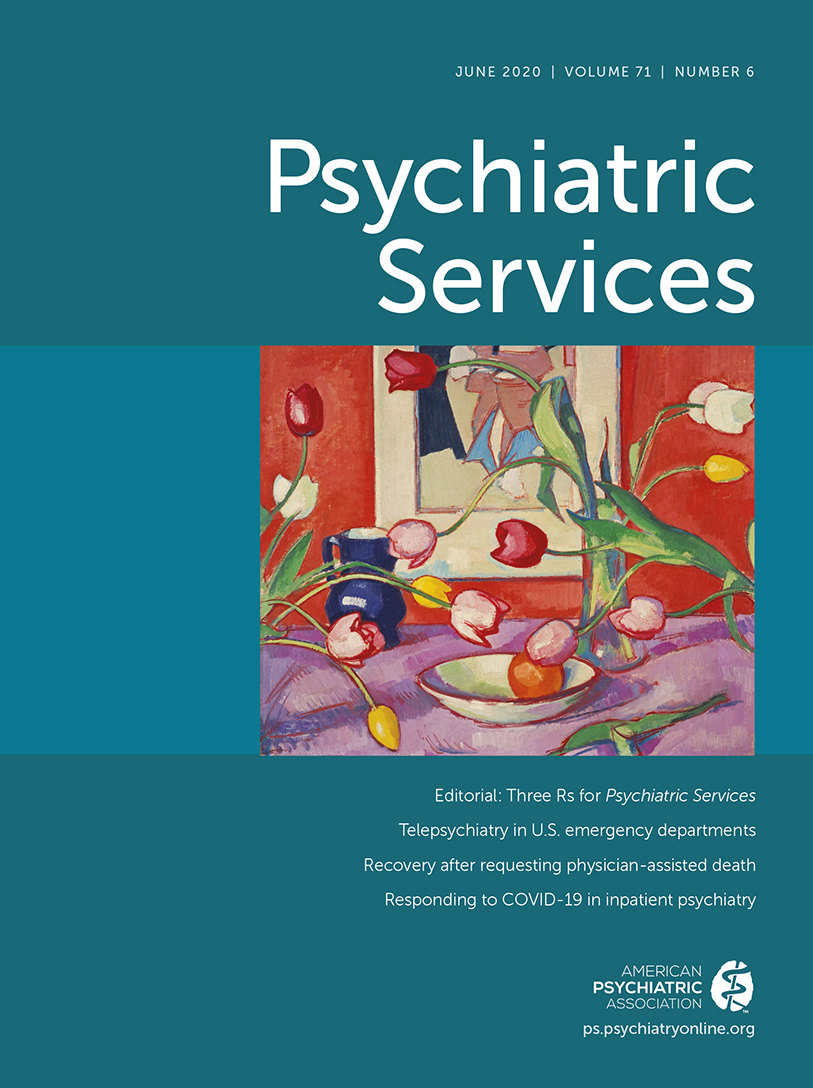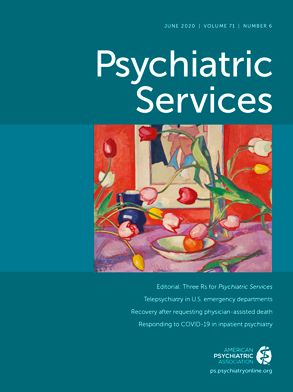xAutism spectrum disorder (ASD) is characterized by persistent deficits in social communication and the presence of repetitive or restrictive behaviors that impact daily functioning (
1). Common co-occurring mental disorders among adults with ASD include anxiety disorders, obsessive-compulsive disorder, and depression (
2–
5). Children meeting surveillance case criteria for ASD in the United States increased from an estimated rate of 1 in 150 in 2002 to 1 in 58 in 2014 (
6). It is unclear whether the rising prevalence of ASD diagnoses is due to actual increases of the disorder or to changing diagnostic and classification practices (
7,
8). Whichever the case, ASD caseloads have dramatically increased across several public programs, including special education (
9,
10), vocational rehabilitation (
11–
14), state developmental disability services (
15–
17), and Medicaid (
18,
19). The growing prevalence of ASD diagnoses raises questions about the best ways to allocate public resources to meet the needs of the growing number of service users (
20–
22).
The Supplemental Security Income (SSI) program, a federally administered income support program, provides means-tested cash benefits to elderly people, people with disabilities, and people who are blind and facilitates access to other services and supports, including Medicaid (
23,
24). Between 2004 and 2014, the proportion of children in the SSI major mental disorders category who were classified as having ASD increased from 8.08% to 20.53%, the largest increase for any diagnostic group (
25). There is no evidence base on SSI program growth among adults with ASD, although recent reports by the Social Security Administration (SSA) include some general statistics on participants with autism as part of a larger overview of SSI (
23). The Interagency Autism Coordinating Committee, a federal advisory committee that provides advice to the Secretary of Health and Human Services on issues related to ASD, calls for the use of population-level data to understand service needs (
26).
The Supplemental Security Income program provides monthly, means-tested cash payments to individuals with disabilities who are unable to work at substantial levels (
23). National standards determine the maximum monthly SSI payment (or federal benefit rate) recipients can receive, although some states provide supplemental payments in addition to federal benefits (
27). The federal benefit rate in 2016 was $733.00 for individuals ($1,100.00 for couples) (
23). In 2016, 8.3 million people received federal SSI payments totaling $52 billion (
23), constituting 1.4% of combined discretionary and mandatory federal spending (
28,
29).
To qualify for SSI, working-age adults (age 18 to 64 years) must meet federally defined income, asset, and medical eligibility criteria (
30). Financial eligibility and benefit amount are contingent upon the levels of resources (assets) or income that an individual has or can obtain. In 2016, an applicant’s or recipient’s assets could not exceed $2,000 for an individual ($3,000 for a couple), although equity in a home, automobiles, and other resources is not counted.
Applicants must also demonstrate they have a physical or mental impairment that will last at least 12 months or result in death and that severely limits their ability to engage in substantial gainful activity. In 2016, substantial gainful activity referred to work activity with compensation of at least $1,130 per month for nonblind individuals (
23). Once an applicant passes this threshold, SSA uses the Listing of Impairments (Listings), which is a codified guide of eligible medical conditions, to determine whether the applicant meets criteria for a physical or mental health impairment (
31). If necessary, an assessment of the severity of an applicant’s functional limitations is also used to determine whether the impairment is severe enough to meet medical eligibility. This assessment includes determining whether the individual can perform his or her previous work or any other job in the national economy.
This study used SSA administrative data to examine population-level trends in SSI program participation and federal payments to adults with ASD and compared these trends with trends for other groups. First, we examined overall trends for all SSI recipients. Second, we examined trends for adults with new SSI awards per year.
Methods
Drexel University reviewed and approved this study for exemption from institutional review board review.
Data
Two SSA administrative sources informed this study: the Supplemental Security Record (SSR) and the 2015 version of the Disability Analysis File (DAF). The SSR contains records for every person who has ever applied for SSI benefits since 1974 and includes information required for the processing of claims and ongoing determination of program eligibility. The DAF contains longitudinal records of individuals with disabilities who received SSI or Social Security Disability Insurance at any time since 1996. The data contained in the DAF are extracted from SSA program files and include information on benefit payments, disability type, and selected individual characteristics. Detailed information about the construction and components of these data are available elsewhere (
32–
34). Both the SSR and the DAF are stored on SSA’s computers and are accessible only to SSA staff with security clearance. A coauthor who is an SSA employee conducted analyses for this study.
We constructed two subsets of data for this study to address each aim. The first subset included all working-age (age 18 to 64 years) SSI recipients who received benefits in at least one month during a given year from January 2005 to December 2015. The second subset included annual cohorts of working-age SSI recipients who received their first adult SSI award in any month between 2005 and 2015. Statistics presented in this study may not match SSA publications (
23,
35) because of differences in the conceptualization of “SSI receipt” (such as monthly versus yearly) and data sources.
Comparison Groups
There are 11 categories of mental disorders within the Listings under which a claimant can qualify for SSI benefits: neurocognitive disorders; schizophrenia spectrum and other psychotic disorders; depressive, bipolar, and related disorders; intellectual disorder; anxiety and obsessive-compulsive disorders; somatic symptom and related disorders; personality and impulse-control disorders; autism spectrum disorder; neurodevelopmental disorders; eating disorders; and trauma- and stressor-related disorders (
31). ASD was added to the Listings in 2001.
Disability adjudicators, either employees of state disability determination services or administrative law judges, are responsible for documenting the primary (and secondary, if present in the evidence) impairment used in the determination of medical eligibility for SSI. The determination of ASD is based on evidence from the applicant’s medical sources or from a physical or mental examination funded by SSA. Extensive rules govern the process and documentation needed for proof of disability. Generally, a case coded with a primary or secondary impairment of ASD is likely to actually have ASD. However, SSI recipients with ASD are sometimes tallied in another impairment category or do not have evidence of ASD in their records.
To provide context for the population with ASD, we compared recipients with a primary or secondary impairment of ASD to those in two groups that were not mutually exclusive: those with a primary or secondary impairment of intellectual disability and those in the overall population of SSI recipients with a documented primary or secondary other mental disorder, which included adults with the remaining nine mental disorders listed within the Listings.
To provide a more detailed picture of changes in SSI program participation among disability groups, adults were counted in more than one category if they had more than one documented impairment. Therefore, an adult with documented ASD and intellectual disability would be counted in both groups. We further disaggregated each disability group based on the presence of an ASD diagnosis, resulting in the following six subgroups: ASD as a primary diagnosis, ASD as a secondary diagnosis, intellectual disability with documented ASD, intellectual disability without documented ASD, other mental disorder with documented ASD, and other mental disorder without documented ASD. We chose intellectual disability and other mental disorder because these conditions and their associated characteristics commonly co-occur with ASD (
36,
37).
Measures and Analysis
We examined caseload size and the number of new adult awardees to measure annual SSI program participation. “Caseload” is defined as the number of adults who received SSI benefits in at least 1 month during a given year. We also reported the distribution of SSI recipients across the ASD, intellectual disability, and other mental disorder groups as a percentage of the total number of recipients with a primary or secondary mental disorder.
“Award” refers to an administrative determination that an individual is entitled to receive monthly benefits (
30). In this study, “new awardees” refers to individuals who were first awarded SSI as an adult and received their first payment in any month between 2005 and 2015. We first measured the number of annual SSI awards to adults across disability groups. Then, we calculated the percentage of awards to adults with ASD relative to the total number of awards given to adults with a documented mental disorder. Our definition of new adult awardees does not include child SSI recipients who continued to receive SSI as an adult or who, after a time of separation from SSI, returned to the program; therefore, our findings understate the total number of new adults receiving SSI under an ASD classification in a given year.
We use the term “SSI payments” when referring to the dollar amount paid to individuals in a given year. We first aggregated SSI payment amounts across individuals to examine total annual expenditures (in thousands of dollars) at the population level. Then, we reported the average annual payment per recipient. We adjusted for inflation to 2015 dollars, using annual values from the Consumer Price Index for Urban Wage Earners and Clerical Workers (
38). The 2015 maximum federal SSI payment was $733 per month for individuals and $1,100 per month for couples (
35). We used SAS, version 9.4, to conduct all analyses for this study.
Results
In 2005, 37,041 adults with ASD received SSI benefits, representing 1.3% of all working-age SSI recipients with a documented mental disorder. By 2015, ASD caseloads increased to 158,105 adults (or 5.0% of recipients with a mental disorder). In 2015, adults with ASD were generally younger (mean±SD age=20.9±5.3 years) and had a higher percentage of males (79.1%), compared with recipients with intellectual disability and other mental disorder (statistics not reported). The composition of recipients with ASD did not significantly change between 2005 and 2015 with respect to diagnosis type, age, and sex. Most adults had ASD listed as the primary impairment for both years (72.2% and 75.3%).
Caseload Size
Figure 1 reports the total number of SSI recipients within each disability group for each year between 2005 and 2015. Although the number of recipients increased for all groups, the growth rate in ASD caseloads exceeded that in the intellectual disability and other mental disorder groups. Between 2005 and 2015, the SSI adult population with ASD grew by 326.8%; whereas the intellectual disability and other mental disorder groups increased by 6.0% and 15.6%, respectively. The number of SSI recipients with ASD increased every year, with the greatest growth occurring between 2005 and 2009 (N=36,191, or 97.71%), which overlaps with the Great Recession. Growth slowed the following years, with an average annual percentage change of 16.3% between 2010 and 2013 and 11.2% between 2013 and 2015. Caseloads for the intellectual disability and other mental disorder groups increased at a slower rate than that for the ASD group and declined significantly between 2013 and 2015.
New Awards to Adults
Slowing caseload growth may be due to decreases in the number of new adult SSI awardees with a mental disorder. As indicated in
Table 1, the total number of adult awardees with mental impairments decreased by 16.2% between 2005 and 2015, while awards to adults with ASD grew from 3,167 to 10,632 (a 235.7% increase). By comparison, total awards to adults with intellectual disability and to adults with other mental disorder declined by 34.2% and 11.9%, respectively. The proportion of adult awardees with intellectual disability who also had documented ASD increased from 10.7% to 54.4% during the study period, suggesting that these decreases are driven by declines in the subpopulation of awardees who do not have documented ASD.
Table 2 summarizes annual federal SSI payments (not including federally administered state supplementations to federal SSI benefits), adjusted to 2015 dollars. In 2015, the ASD group received 5.3% (roughly $1.0 billion) of total federal SSI payments to recipients with mental disorders (just over $19.6 billion); the intellectual disability group received 33.8% and the other mental disorder group received 75.1% of these payments. Because the three disability groups are not mutually exclusive, the sum payments across groups is larger than the total percentage and dollar amounts indicated in
Table 2. The average annual federal payment to adults with ASD was $6,527.40 in 2015, which is higher than the average annual federal payment to either the intellectual disability group ($6,270.40) or the other mental disorder group ($6,163.70). There are several reasons why these amounts are less than the full benefit amount, such as concurrent receipt of disability insurance and the presence of earnings, which we did not explore in this paper. It should be noted that the SSI program serves as a point of entry for health insurance, and many SSI recipients are also enrolled in Medicaid. Our measure of SSI expenditures does not account for rising health care expenses.
Discussion
Supplemental Security Income plays an important role in securing the economic well-being of adults with ASD. In 2015, 158,105 adults with ASD relied on SSI benefits. To put this number in context, special education services covered 575,796 students with ASD (
39) and vocational rehabilitation services closed 17,753 cases for service users with ASD in 2014 (
40). The proportion of adult SSI recipients with ASD increased between 2005 and 2015, and this growth is consistent with the growth rates reported for child SSI recipients with ASD (
25). Although the total annual SSI payments to adults with ASD increased, the growth in the average federal payment per recipient was smaller. This finding suggests that the increase in SSI payments is largely driven by increases in the number of adults served, and not by increased costs per recipient.
Growth in ASD caseloads exceeded that of the growth in the total population of recipients with mental disorders; thus, increases in ASD caseload size are not a result of overall SSI program growth. Other related explanations for caseload growth could include growing awareness of ASD and changing diagnostic practices and criteria (
7). Our findings also suggest that changes in the labor market have important implications for SSI program participation. Consistent with research showing an inverse association between adult SSI applications and the U.S. unemployment rate (
41), the greatest growth in ASD caseload size occurred between 2005 and 2009 (during the Great Recession), despite there having been no significant changes in SSA policies or eligibility criteria. Future research aimed at identifying the determinants of ASD caseload is needed.
The inverse association between the change in the ASD caseload and the change in the intellectual disability caseload suggests that diagnostic substitution may contribute to the growth in the ASD caseload. Diagnostic substitution occurs when changes in diagnostic procedures lead to the replacement of one diagnosis (i.e., intellectual disability) with another (i.e., ASD), resulting in an apparent increase in prevalence of the second condition (
42). The potential role of diagnostic substitution among children and adolescents with ASD has been supported in previous research (
9,
11,
25,
42). However, the magnitude of the decline of the intellectual disability and other mental disorder SSI caseloads is not comparable to the magnitude of growth seen in the ASD group, which suggests that diagnostic substitution may not fully explain group differences. We note that ASD is distinct from intellectual disability and can be impairing enough to qualify for assistance. Evidence from community-based samples suggests that the recent growth in ASD prevalence is concentrated in subpopulations of individuals without co-occurring intellectual disability (
43,
44), reinforcing that ASD can be severely disabling even if it is not accompanied by intellectual disability. To shed light on these issues, future research could disaggregate ASD samples by the presence or absence of intellectual disability. A more nuanced assessment of group differences among subgroups of adults with mental health impairments could also provide useful information, given high rates of comorbid conditions among the ASD population.
These data provide tabulations of the population of new adult SSI recipients within a given year, which is a major advantage for policy monitoring and evaluation. However, the data do not capture the entire population that might be eligible for SSI. We can determine the number of program participants with ASD, but not the proportion of the potentially eligible population of adults with ASD who participate in SSI. Despite this limitation, our study addresses a critical gap in existing research by reporting accurate data on program participation and expenditures for SSI recipients with ASD. Building an accurate description of this population is necessary to identify the optimal means of service delivery targeting individuals with ASD. Future research can extend this area of inquiry by examining how adults with ASD interact with the SSI program across the life course and how these interactions are related to later outcomes.


